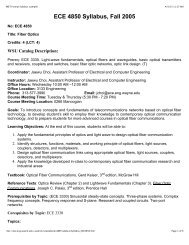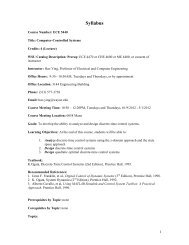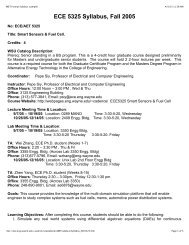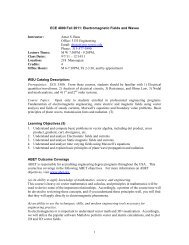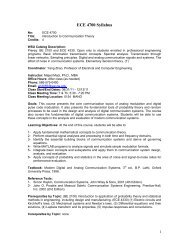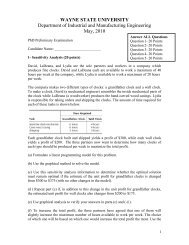Supply chain focus dependent supplier selection problem
Supply chain focus dependent supplier selection problem
Supply chain focus dependent supplier selection problem
Create successful ePaper yourself
Turn your PDF publications into a flip-book with our unique Google optimized e-Paper software.
G. Vanteddu et al. / Int. J. Production Economics 129 (2011) 204–216 207(Axsäter, 1993; Graves, 1985; Lee and Moinzadeh, 1987a, b). Forcapacitated models using a modified base stock policy, the readercan refer to Glasserman and Tayur (1995, 1996) and Kapuscinskiand Tayur (1999). For a thorough comparison of installation andechelon stock policies for multi-level inventory control, the readeris referred to Axsäter and Rosling (1993). They primarily considerserial and assembly systems and prove that for (Q, r) rules echelonstock policies are, in general, superior to installation stock policies.Advocating the necessity of models that include both costand responsiveness, which are the primary order winners in ourstrategic model, Moon and Choi (1998) suggest extending the leadtime reduction concept to other inventory models to justify theinvestment to reduce the lead times. Choi (1994) used an expeditingcost function to reduce the variance of <strong>supplier</strong>’s lead times. Asopposed to network design models that <strong>focus</strong> on the tradeoffbetween the fixed costs of locating facilities and variabletransportation costs between facilities and customers, Sourirajanet al. (2007) present a model for single product distribution networkdesign <strong>problem</strong> with lead times and service level requirements,which enables them to capture the tradeoff between lead times andinventory risk pooling benefits. The objective is to locate distributioncenters (DCs) in the network such that the sum of the location andinventory (pipeline and safety stocks) costs is minimized.One very interesting (Q, r) model with stochastic lead times thatcould serve as a building block in supply <strong>chain</strong> management isproposed by Bookbinder and Cakanyildirim (1999) as opposed toconstant lead time assumption in many other studies. Thedimensionless quantity CIR proposed in our model is similar in spiritto the ‘‘expediting factor’’ for the lead time proposed by them. Ryu andLee (2003) consider dual sourcing models with stochastic lead times inwhich lead times are reduced at a cost that can be viewed as aninvestment. They make use of the concept of ‘‘expediting factors’’proposed by Bookbinder and Cakanyildirim (1999) in their model. Theyanalyze (Q, r) models with and without lead time reduction andcompare the expected total cost per unit time for the two models.Even though, we did not consider the product mix flexibilityrelated issues in our model, the reader can refer to Upton (1997) forexploring the relationship between process range flexibility andstructure, infrastructure and managerial policy at the plant level.We assume information symmetry at all the stages in our model.The effect of information sharing for time series structure of thedemand on safety stocks is addressed in Gaur et al. (2005). Eventhough we did not address environmental issues, reader can referto Wolf and Seuring (2010) who analyze whether environmentalissues form a <strong>supplier</strong> <strong>selection</strong> criteria of companies when sourcingthird party logistics (3PL) services.3. Model developmentAt any stage in supply <strong>chain</strong> primarily there are two types ofinventory elements namely cycle inventory (in-process inventory)and safety inventory. The quantity of cycle inventory depends onthe average demand per period and the average cycle (processing)time and is given by the multiplied product of those two quantities.Among inventory cost elements, safety stock, which is maintainedto account for the internal and external variability in a supply <strong>chain</strong>,is vital in the sense that it directly affects customer satisfaction andsafety stock costs also constitute a significant portion of the cost ofgoods at a stage. We are considering both cycle stocks (in-processinventory) and safety stocks in our model. Responsiveness relatedcosts are the costs incurred on account of the volume relatedflexibility at any stage in a supply <strong>chain</strong>, the inclusion which intothe model is made possible by the inclusion of a new parametercalled coefficient of inverse responsiveness (CIR). The inclusion ofCIR also facilitates the explanation of the interrelationship betweeninventory costs and the responsiveness related costs.At any stage in a supply <strong>chain</strong>,Total cost¼Safety stock costs+Cycle stock costs+Responsivenessrelated costsThis section is devoted to developing total cost expression,made up of safety stock costs, cycle stock costs and responsivenessrelated costs, for a serial supply <strong>chain</strong>.3.1. Expression for safety stock costsThe content in Sections 3.1 and 3.2 is largely adopted fromVanteddu et al. (2007).We follow the building block model (Gravesand Willems, 2003) with installation base stock policies and acommon underlying review period for all stages. A typical basestock policy works as follows.When the inventory position (i.e., onhand plus on order minus back orders) at stage i falls below somespecified base stock level B i , the stage places a replenishment orderthereby keeping the inventory position constant. Simchi-Levi andZhao (2005) attribute the popularity of base stock policy to the factthat it is simple, easily implementable, and because this policy hasbeen proven to be optimal or close to optimal in many cases. Forexample, in serial supply <strong>chain</strong>s with zero setup costs and withoutcapacity constraints, because the installation base stock policy isequivalent to an echelon base stock policy under certain initialconditions (Axsäter and Rosling, 1993), it is indeed optimal in thesecases (Clark and Scarf, 1960).In serial systems, even modified basestock policy with capacity constraints is still close to optimal (Speckand vander Wal, 1991; Van Houtum et al., 1996)In an installation policy, each facility only needs the inputs fromthe immediate upstream (U/S) and downstream (D/S) facilities andmakes ordering decisions based on its local order and inventorystatus (Simchi-Levi and Zhao, 2005) as opposed to an echelon basestockpolicy, which is a centralized control scheme that allows for acentral decision maker to coordinate and control the actions at allstages in the SC (Graves and Willems, 2003).Even though our model assumes all the stages to be manufacturingstages, without loss of generality, a stage could be modeledas a distribution center (DC) as well. A pure transportation functioncan also be modeled with the building block concept, wherein thetransport time is the lead time with pipeline inventories.Orders are placed at discrete time intervals and each stage isconsidered as a building block (Graves, 1988) that generates astochastic lead time. A building block is typically a processor plus astock keeping facility (Simchi-Levi and Zhao, 2005). Depending onthe scope and granularity of the analysis being performed, the stagecould represent anything from a single step in manufacturing ordistribution process to a collection of such steps to an entireassembly and test operation (Graves and Willems, 2003). Demandis assumed to be stationary and uncorrelated across different timeperiods with no capacity constraints.Our model is designed as a decentralized supply <strong>chain</strong> (Gravesand Willems, 2003; Lee and Billington, 1993) to mimic the realitymore closely with each stage following a local base-stock policy.Buttressing the same view, Lee and Billington (1993) state thatorganizational barriers and restricted information flows betweenstages may result in complete centralized control of material flowin a supply <strong>chain</strong> to be not feasible or desirable.The primary distinction between centralized and decentralizedsupply <strong>chain</strong> is put in the following succinct form by Lee andBillington (1993) ‘‘Centralized control means that decisions on howmuch and when to produce are made centrally, based on materialand demand status of the entire system. Decentralized control, onthe other hand, refers to cases where each individual unit in thesupply <strong>chain</strong> makes decisions based on local information’’.








